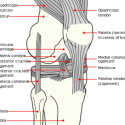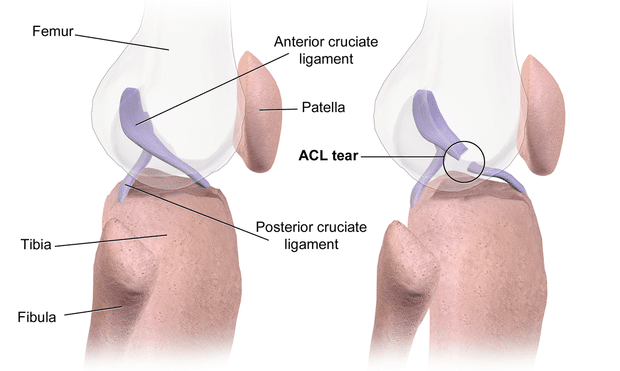MedicalResearch.com Interview with:
Karin Magnusson PT, PhD
Associate Researcher
Lund University and
Norwegian Institute of Public Health
MedicalResearch.com: What is the background for this study?
Response: Anterior cruciate ligament (ACL) injury is one of the most common knee injuries, for which very limited data has been presented on the genetic contribution. Based on our knowledge of the role of genetics in the development of ACL-rupture related traits, such as joint hypermobility and knee osteoarthritis, we hypothesized that heritability might play a role also in ACL injury.
Using the Swedish Twin Registry, which is the world's largest twin registry and in this study including more than 88.000 twins, we had unique data to for the first time reliably estimate the heritability for this common knee injury. (more…)
 MedicalResearch.com Interview with:
Adam Culvenor Ι B.Physio(Hons), PhD
Division of Physiotherapy
School of Health & Rehabilitation Sciences
The University of Queensland
Medical Research: What is the background for this study?
Dr. Culvenor: Knee injury, such as anterior cruciate ligament (ACL) rupture, is a well-recognised risk factor for the accelerated development of knee osteoarthritis (OA). Previous studies report high rates of knee osteoarthritis with radiographs (x-rays) more than 5-10 years following ACL injury and reconstruction (ACLR). However, once OA becomes well-established and visible on radiographs, management options are limited. Potential therapies may be better placed to target the early stages of disease when management strategies, such as optimising knee load, may be more efficacious. Magnetic resonance imaging (MRI) enables the assessment of early osteoarthritis features affecting any joint tissue. Yet, MRI has not previously been used to assess early knee OA within the first year following ACLR.
Medical Research: What are the main findings?
Dr. Culvenor: Of the 111 patients who were one year following an anterior cruciate ligament rupture, the prevalence of early knee OA assessed with MRI was much higher than previously recognised. Medial and lateral tibiofemoral osteoarthritis was observed in 6% and 11%, respectively, while 17% had patellofemoral OA. These patterns of early OA are similar to previous radiographic findings; the patellofemoral joint is at particular risk of OA. Specifically, the femoral trochlea was the region most affected by bone marrow lesions, cartilage lesions and osteophytes. The prevalence of structural pathology was much higher than the uninjured control group of similar age and activity level, highlighting the impact of knee trauma (injury and/or surgery).
(more…)
MedicalResearch.com Interview with:
Adam Culvenor Ι B.Physio(Hons), PhD
Division of Physiotherapy
School of Health & Rehabilitation Sciences
The University of Queensland
Medical Research: What is the background for this study?
Dr. Culvenor: Knee injury, such as anterior cruciate ligament (ACL) rupture, is a well-recognised risk factor for the accelerated development of knee osteoarthritis (OA). Previous studies report high rates of knee osteoarthritis with radiographs (x-rays) more than 5-10 years following ACL injury and reconstruction (ACLR). However, once OA becomes well-established and visible on radiographs, management options are limited. Potential therapies may be better placed to target the early stages of disease when management strategies, such as optimising knee load, may be more efficacious. Magnetic resonance imaging (MRI) enables the assessment of early osteoarthritis features affecting any joint tissue. Yet, MRI has not previously been used to assess early knee OA within the first year following ACLR.
Medical Research: What are the main findings?
Dr. Culvenor: Of the 111 patients who were one year following an anterior cruciate ligament rupture, the prevalence of early knee OA assessed with MRI was much higher than previously recognised. Medial and lateral tibiofemoral osteoarthritis was observed in 6% and 11%, respectively, while 17% had patellofemoral OA. These patterns of early OA are similar to previous radiographic findings; the patellofemoral joint is at particular risk of OA. Specifically, the femoral trochlea was the region most affected by bone marrow lesions, cartilage lesions and osteophytes. The prevalence of structural pathology was much higher than the uninjured control group of similar age and activity level, highlighting the impact of knee trauma (injury and/or surgery).
(more…) MedicalResearch.com Interview with:
Dr. Bruce Beynnon
McClure Professor of Musculoskeletal Research
Dept Orthopedics and Rehabilitation
University of Vermont College of Medicine
Burlington, VT 05405-0084
Medical Research: What are the main findings of the study?
Dr. Beynnon: The anterior cruciate ligament (ACL) is an important stabilizer of the joint, and the study investigated how geometry of this ligament and surrounding bone is related to non-contact injury of this ligament. Specifically, the study focused on MRI-based measurements of the size of the ACL, measured as its volume, and the size of the femoral intercondylar notch, or the small space located in the center of the femur in which the ACL resides. Our study revealed that a decrease in the volume of the ACL and a decrease in the size of the intercondylar notch were associated with an increased risk of suffering a non-contact ACL injury in athletes.
This finding may be explained by the fact that a smaller ligament is associated with a decrease in its biomechanical properties, such as a smaller ultimate failure load. An alternative explanation is that a decreased femoral intercondylar notch size could result in a greater tendency for the ACL to impinge against the walls of the femoral notch during high demand activities, and increase the risk of injury.
The investigation was a longitudinal study with a nested case-control analysis of young, healthy high school and college athletes. The investigation was rigorously designed to control for age, sex, and participation on the same sports team. This enabled us to determine which combination of geometric parameters of the ACL and adjacent bony structures influence risk of suffering a first time non-contact ACL injury.
(more…)
MedicalResearch.com Interview with:
Dr. Bruce Beynnon
McClure Professor of Musculoskeletal Research
Dept Orthopedics and Rehabilitation
University of Vermont College of Medicine
Burlington, VT 05405-0084
Medical Research: What are the main findings of the study?
Dr. Beynnon: The anterior cruciate ligament (ACL) is an important stabilizer of the joint, and the study investigated how geometry of this ligament and surrounding bone is related to non-contact injury of this ligament. Specifically, the study focused on MRI-based measurements of the size of the ACL, measured as its volume, and the size of the femoral intercondylar notch, or the small space located in the center of the femur in which the ACL resides. Our study revealed that a decrease in the volume of the ACL and a decrease in the size of the intercondylar notch were associated with an increased risk of suffering a non-contact ACL injury in athletes.
This finding may be explained by the fact that a smaller ligament is associated with a decrease in its biomechanical properties, such as a smaller ultimate failure load. An alternative explanation is that a decreased femoral intercondylar notch size could result in a greater tendency for the ACL to impinge against the walls of the femoral notch during high demand activities, and increase the risk of injury.
The investigation was a longitudinal study with a nested case-control analysis of young, healthy high school and college athletes. The investigation was rigorously designed to control for age, sex, and participation on the same sports team. This enabled us to determine which combination of geometric parameters of the ACL and adjacent bony structures influence risk of suffering a first time non-contact ACL injury.
(more…) MedicalResearch.com Interview with:
Christoher C. Kaeding M.D.
Judson Wilson Professor, Department of Orthopaedics
Executive Director, Sports Medicine Center
Head Team Physician, Department of Athletics
The Ohio State University
MedicalResearch: What are the main findings of the study?
Dr. Kaeding:
MedicalResearch.com Interview with:
Christoher C. Kaeding M.D.
Judson Wilson Professor, Department of Orthopaedics
Executive Director, Sports Medicine Center
Head Team Physician, Department of Athletics
The Ohio State University
MedicalResearch: What are the main findings of the study?
Dr. Kaeding:
- Younger age and high activity level were predictors off another ACL injury after an ACL Reconstruction.
- Allograft use in younger more active patients Had an increased risk of re-injury.

